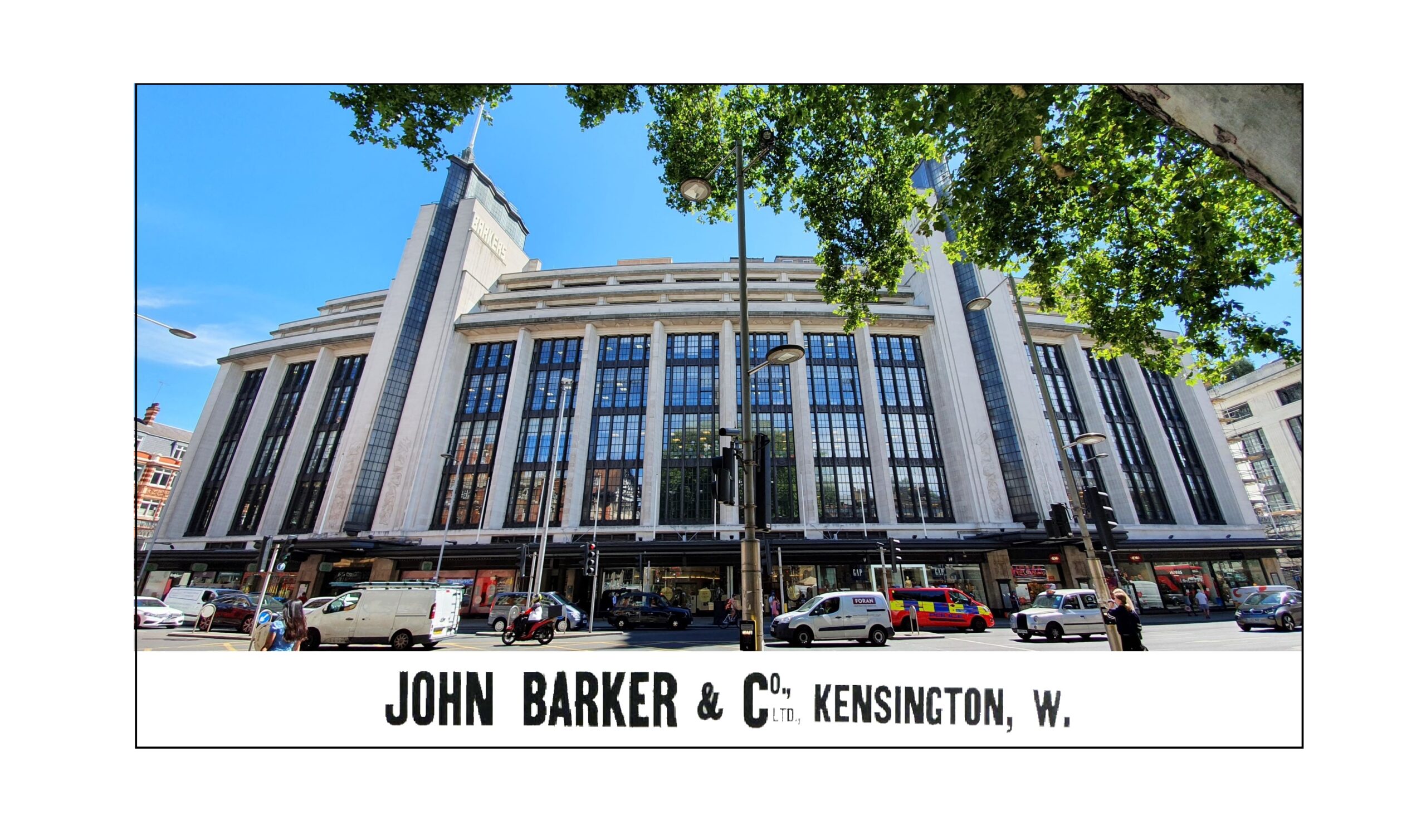
For every Harrods there is a dusty, abandoned Swan & Edgar; for every Selfridges a liquidated Bourne & Hollingsworth. Some buildings don’t long outlive their tenants – the Victorian splendours of Gamages at Holborn Circus and Marshall & Snelgrove on Oxford Street were lost in the 1970s – but the streets of London are littered with impressive buildings that once housed impressive department stores, with their own particular customer base, reputation and position in the market.
The stories behind their demise are sometimes sad, occasionally intriguing, and often involve the hand of Debenhams or the decline and fall of the House of Fraser. Here are a just few of them.
I was a young man when Bourne & Hollingsworth (1894-1982) on Oxford Street finally closed. I could see how pathetic it was, as floor after floor was sealed off and the last days were spent selling cheap rubbish and store fittings – a scene repeated more recently with Woolworth and BHS. An academic examination of its failure suggested innate conservatism of approach combined with a poor retail location and high value of property for other purposes (Ashmore et al, 2012). Or, as I would put it, boring shop in the wrong place worth more as offices. It was independent of the big chains to the end – but as a listed company it was ripe for takeover by a property developer, and an offer too-good-to-refuse finally came in 1979. That made closure inevitable.

← The lower floors were reconstructed as a shopping centre called the Plaza, but in recent years much of the surviving retail space has become a branch of Next, with offices above. The initials B and H are still on the exterior green metalwork, though not visible here.
→ A Fitzrovia bar, with no connection to the original store, continues the name.
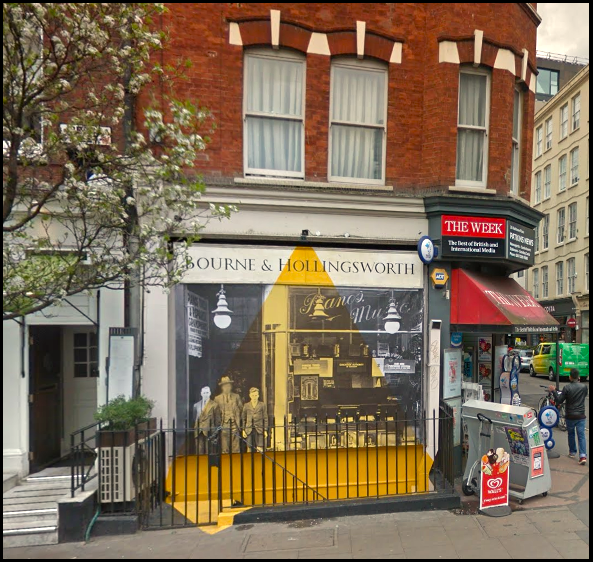
Close to Bourne & Hollingsworth sat the impressive Waring & Gillow (1730-2015) store at 164-188 Oxford Street. Built in 1906 to a free renaissance design by R. Frank Atkinson, it was not so much a department store as a vast furniture and homeware emporium over 6 floors, also selling antique furniture. The Historic England listing (grade II) drifts into rhapsodies, describing the ‘riotous application of Hampton Court inspired “Wrenaissance” details well suited to the Empire-wide pretensions of the store’
A vast company with interests in construction – it built the Ritz Hotel in London – as well as the furnishing of ocean liners and public buildings as far apart as India and South America, it flirted with bankruptcy several times before a much slimmed-down enterprise was bought by Great Universal Stores in 1955. The huge Oxford Street store was abandoned – after a 200 year presence in the area – in the early 1970s: the economic and geographic factors that did for Bourne & Hollingsworth also put paid to its neighbour. The business moved to Regent Street for a decade, and the name had been consigned to the history books long before the demise of its last owner, Allied Carpets, in 2015.
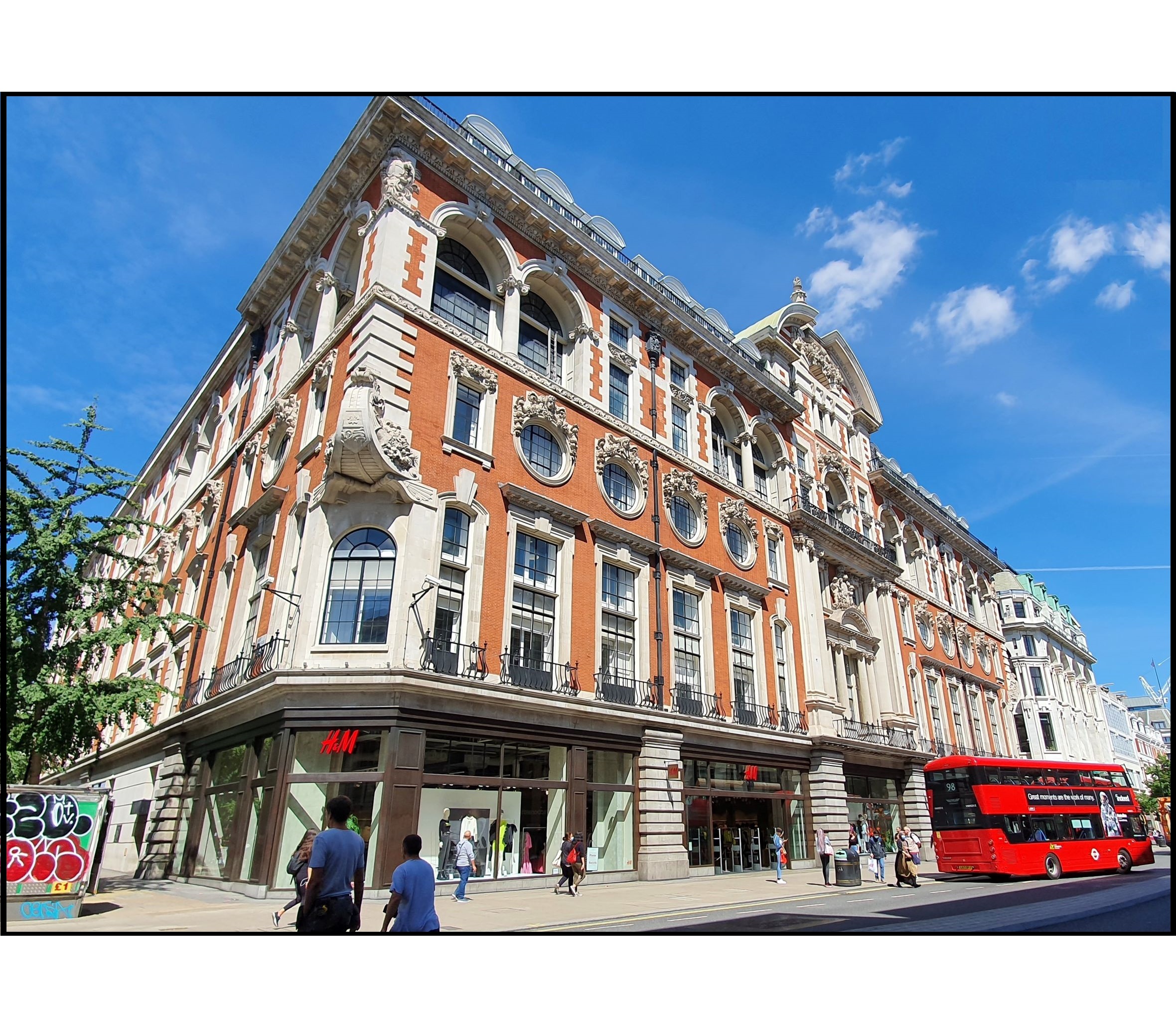
← I can’t get quite as carried away as Historic England, but it is a memorable exterior. It narrowly escaped total destruction when it was listed in 1973 after pressure from the Victorian Society, but the interior – including a central rotunda -was lost in 1977. Chain stores now occupy the lower floors, with – you guessed it – offices above.
Debenhams (founded 1778) is still with us – just – but here we focus on the former flagship store on Wigmore Street, a block north of the current Debenhams on Oxford Street. Built in 1907 as Debenham & Freebody when a former junior partner still got second billing, it is a remarkable ‘baroque revival’ building covered completely in white Doulton Carrara tiles (says the Historic England listing). Close to a far better part of Oxford Street than the two unfortunates discussed above, its downfall lay in being close to rather than on. It would still make a magnificent retail experience, if only there was a call for one in narrow Wigmore Street. There isn’t.
Debenhams demolished its nearby Marshall & Snelgrove subsidiary on Oxford Street in 1973 and built its own new flagship store there. The abandoned Wigmore Street building has undergone some internal rebuilding, acquiring extra attic floors in the process. However, there remains a grand marble-clad entrance hall with columns and a marble staircase and, according to Historic England, the first floor front rooms still have much of their original plasterwork. It is now occupied by showrooms and, it goes without saying, offices.
→ The lack of exact symmetry suggests the company expected at some point to acquire 25 Wigmore Street (just partially in shot, extreme left) and thus extend east to Wimpole Street. It doesn’t detract from the impressive impact of the frontage on Wigmore Street. The rear wall of its successor Oxford Street store is the modern, blank apparition in the right background.
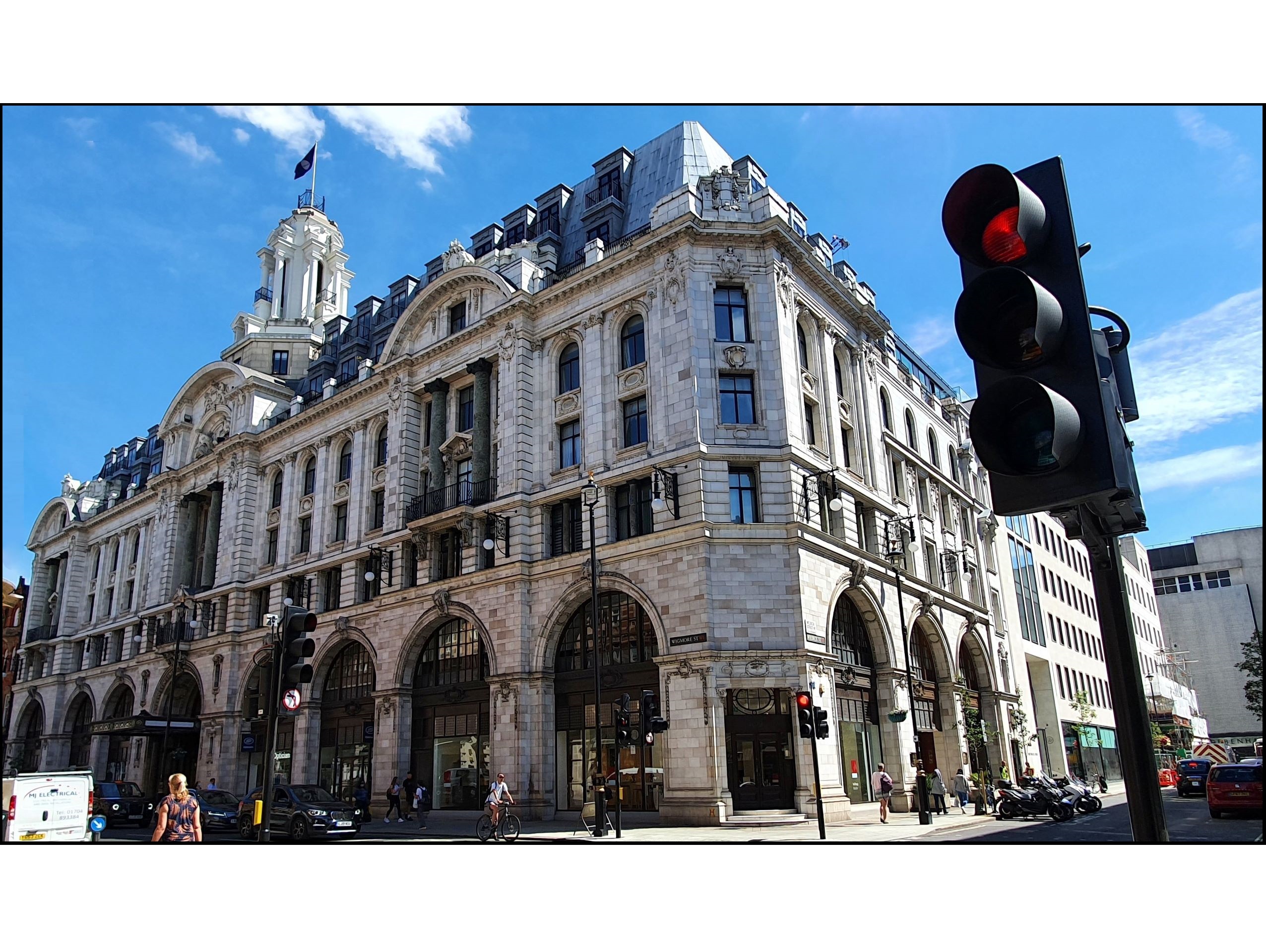
Peter Robinson (1833-1979) occupied one of the four quadrants of Oxford Circus. Holding a lower-middle class position similar to Debenhams, it was bought out by the Burton Group (now Philip Green’s Arcadia) in 1946. In a rare case of retail patricide, it was killed off when its own offspring, the youth-focused clothing department Topshop, proved to be far more profitable than Pa. Topshop and younger sibling Topman still occupy a small part of the 1912 listed family home.
→ The facade was badly damaged in the Blitz but fully restored. The part facing Oxford Circus is now a Nike superstore.
A remarkable survivor is the former restaurant on the top floor, with barrel roof and murals by George Murray. It makes for a very stylish Topshop accounts department. There is a picture on the UCL/Survey of London site.
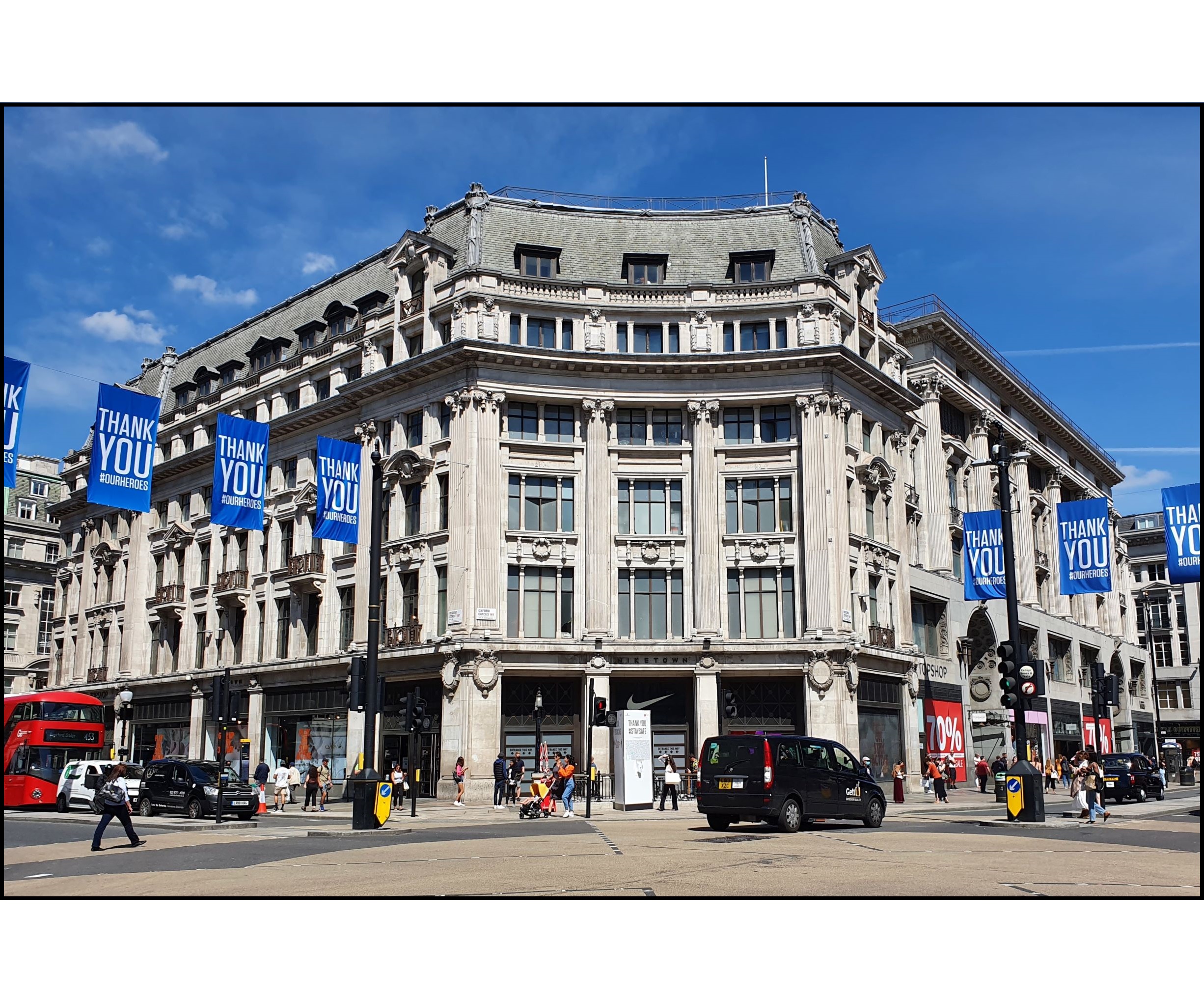
A stone’s throw from Peter Robinson, Dickens & Jones (1790 – 2006) was a considerably more upmarket store on Regent Street. Bought by Harrods in 1914, which in turn was bought by House of Fraser in 1959. Very much a destination for middle-class-ladies-of-a-certain-age-who-lunch, in its final years it had a small in-store Caffè Nero looking out over Argyll Street, which was great for people-watching and as far as I could tell was the only reason anyone else would want to patronise the place. Frasers blamed closure on the high rent; it has since resurrected the name for a line of middle-class-ladies-of-a-certain-age-who-lunch clothing. No surprise there.
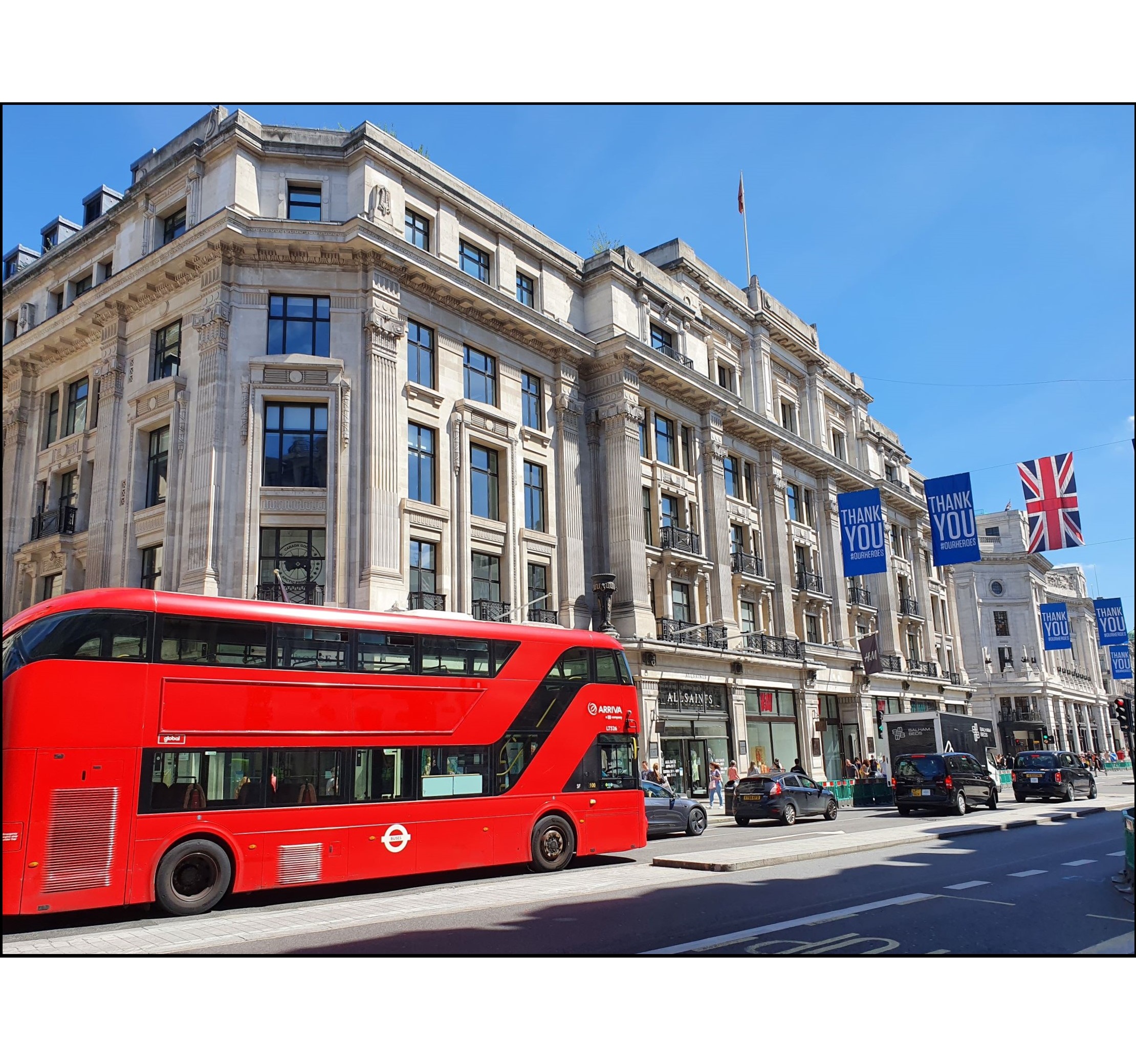
← The Dickens & Jones building has been converted into the inevitable ‘smaller stores, offices and upmarket apartments’ combo. Still a very dignified – if rather bland – frontage, but there’s no longer a Caffè Nero at the back. Listed grade II.
Next door to the former Dickens & Jones, we can go even more upmarket…
Liberty (founded 1875) is still very much alive, but no longer in this noble edifice facing Regent Street. The company owned the freehold of land on Great Marlborough Street, but only a Crown Estate lease on the adjacent Regent Street plot. Planning regulations barred the self-consciously over-the-top Tudor look already used on Great Marlborough Street on Crown Estate land, so in 1924 Liberty built instead the magnificent East India House, faced in Portland stone, to hide the timber-framed confection from easily offended Crown Estate eyes.
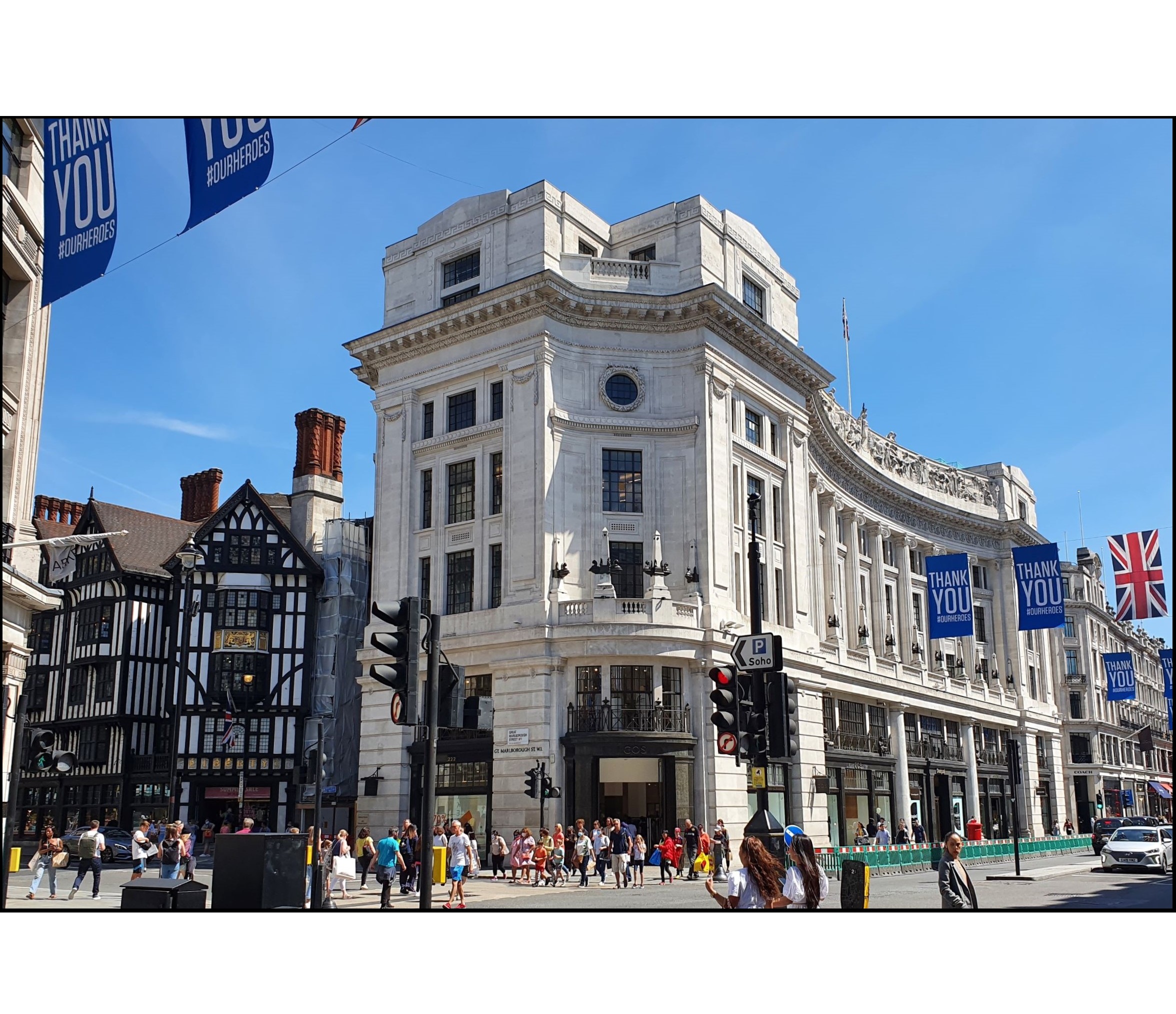
← A view of the two parts of Liberty. The company has consolidated its retail area in its grade II* listed oak- and teak-lined Great Marlborough Street HQ. East India House has lost most of its original interior, and now contains branches of the usual chain store suspects with – inevitably – offices above.
Adorning the concave frontage is a frieze 35 metres long, celebrating the wealth of distant countries being borne by camel, elephant and ship to Britannia. This is very much in keeping with the orient-inspired Liberty style of the time, and explains the building’s name. The previous East India House, home of the East India Company and situated in Leadenhall Street in the City, had been demolished in 1861.
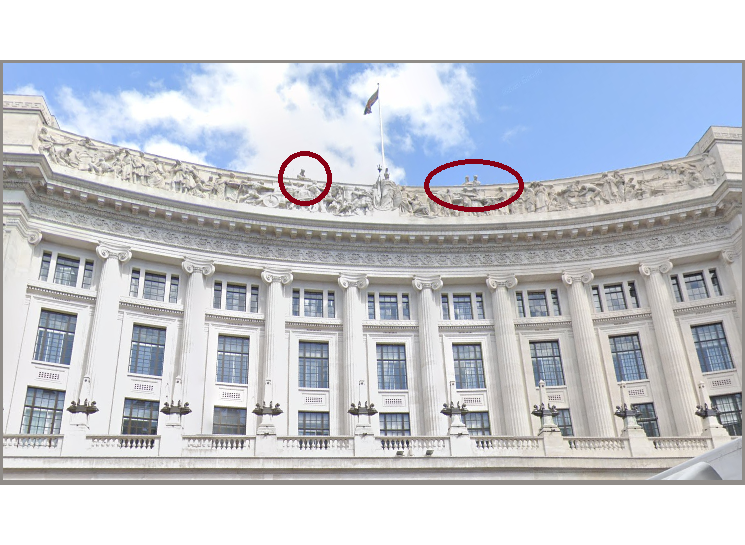
← Peering over the top of the frieze, either side of the figure of Britannia in the centre, are some stone figures of people (circled). It’s a very humorous architectural conceit but I’ve often wondered whether many passers-by look up and notice them.
Continue walking down Regent Street and you’ll come to the 1923 building once occupied by Swan & Edgar (c.1810-1982) on Piccadilly Circus. This was another store that closed during my teenage years; I vaguely remember that it held no interest for me (as a slightly rebellious youth) – it seemed a tedious run-of-the-mill store parents would like. A shame, as it had had an eventful history involving both Suffragettes (they broke the windows) and Zeppelins (one dropped bombs on it in 1917). It closed in 1982 as part of the Debenhams group, having passed through the hands of Harrods and the Drapers Trust; the cause was stated to be the cost of renovation.
The building now seems to have a retailers’ curse: Tower Records, Virgin, Zavvi and The Sting have come and gone in rapid succession. It was listed grade II in the early 1970s, when progress goons proposed leveling and rebuilding the whole of Piccadilly Circus. I’m unsure if the interior was ever of interest, but it certainly isn’t now.
↓ Eros (so-called) staring at the former Swan & Edgar, waiting for the next unsuspecting retailer to lose their shirt. The statue actually represents Anteros, the Greek God of requited (or selfless) love and Eros’ brother. To keep easily offended Victorians happy it was officially referred to as the Angel of Christian Charity.
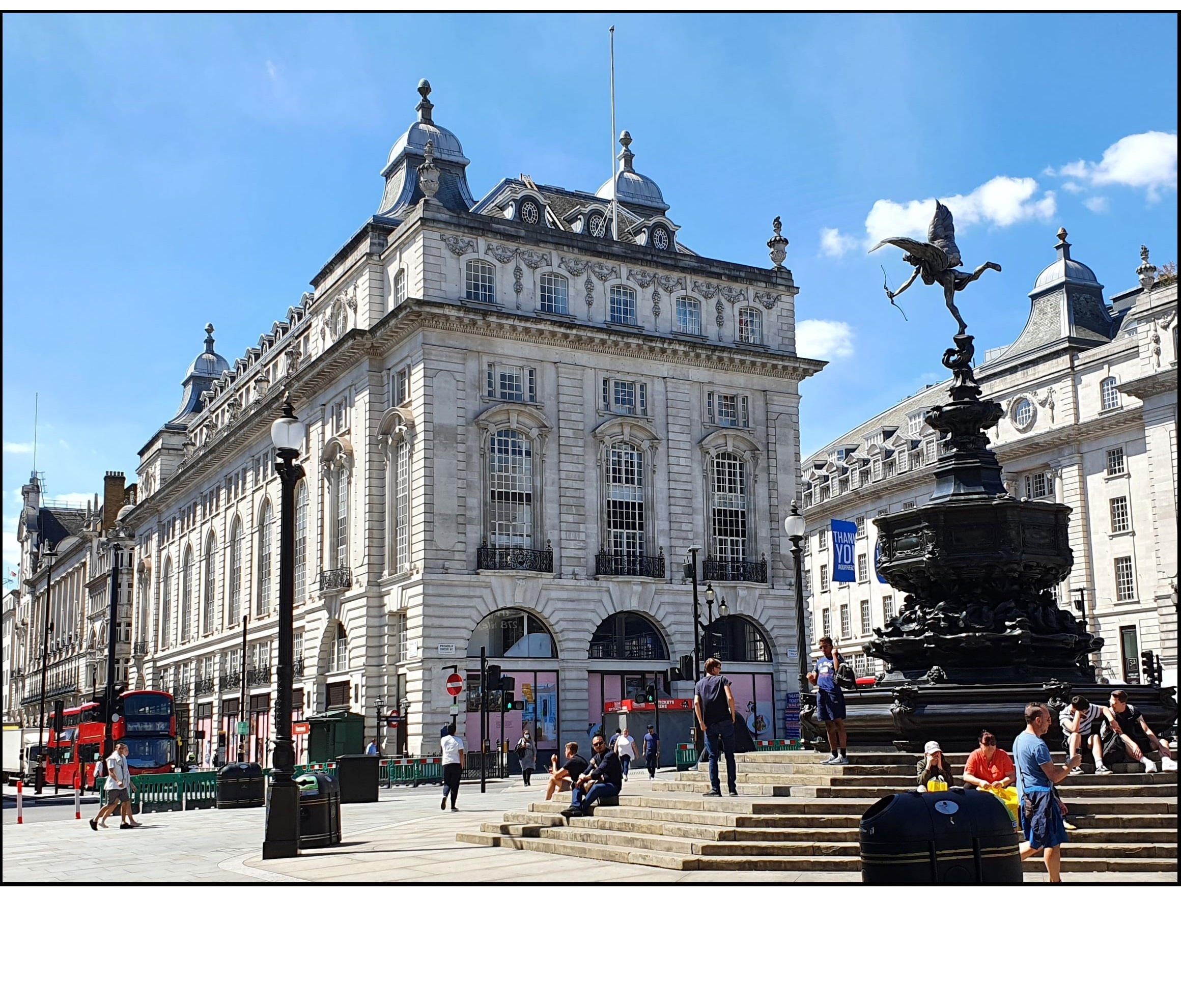
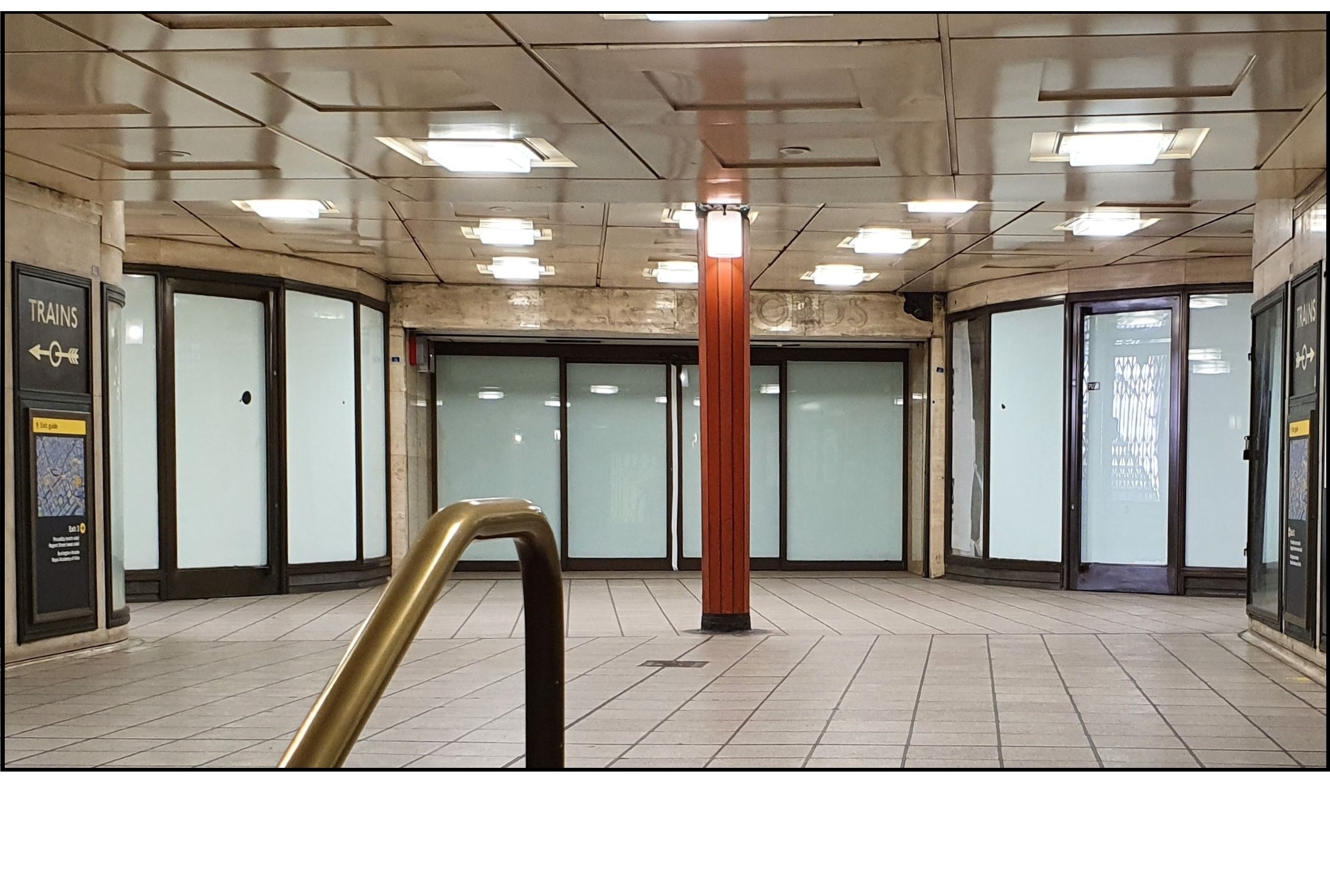
↗ This Piccadilly Circus tube station exit includes former Swan & Edgar display windows and a direct entrance to the store, currently empty. The station concourse is itself listed grade II.
The Bourne & Hollingsworth bar mentioned earlier bought a pub in Marylebone and renamed it the Swan & Edgar, but this closed in 2013. I see that the name, like Gamages, has now been resurrected as a moderately-priced watch brand on the QVC shopping channel. Mr Swan and Mr Edgar must be turning in their graves.
The second victim of House of Fraser I’ve included here is the mighty Barker’s of Kensington (1870-2007). The building on Kensington High Street is a colossal art deco masterpiece. Designed by Bernard George, it was completed in 1958 after building work was interrupted by the war. Barker’s was bought by Frasers in 1957, and its floor space progressively reduced by internal redevelopment of the building completed in 1986. Final closure brought to an end the century-long domination of Kensington High Street by John Barker & Co – and more thankfully, the cheap TV ads featuring barking dogs.
It is now offices, of course, with a large branch of Whole Food Market in the basement and various other all-too-predictable emporia and food outlets. At least one of them – Dishoom, the Indian restaurant – brings something of the art deco glamour vividly back to life.
→ The amazing High Street frontage, See also the title picture. Listed grade II. The Barkers name is still on the towers for all to see.
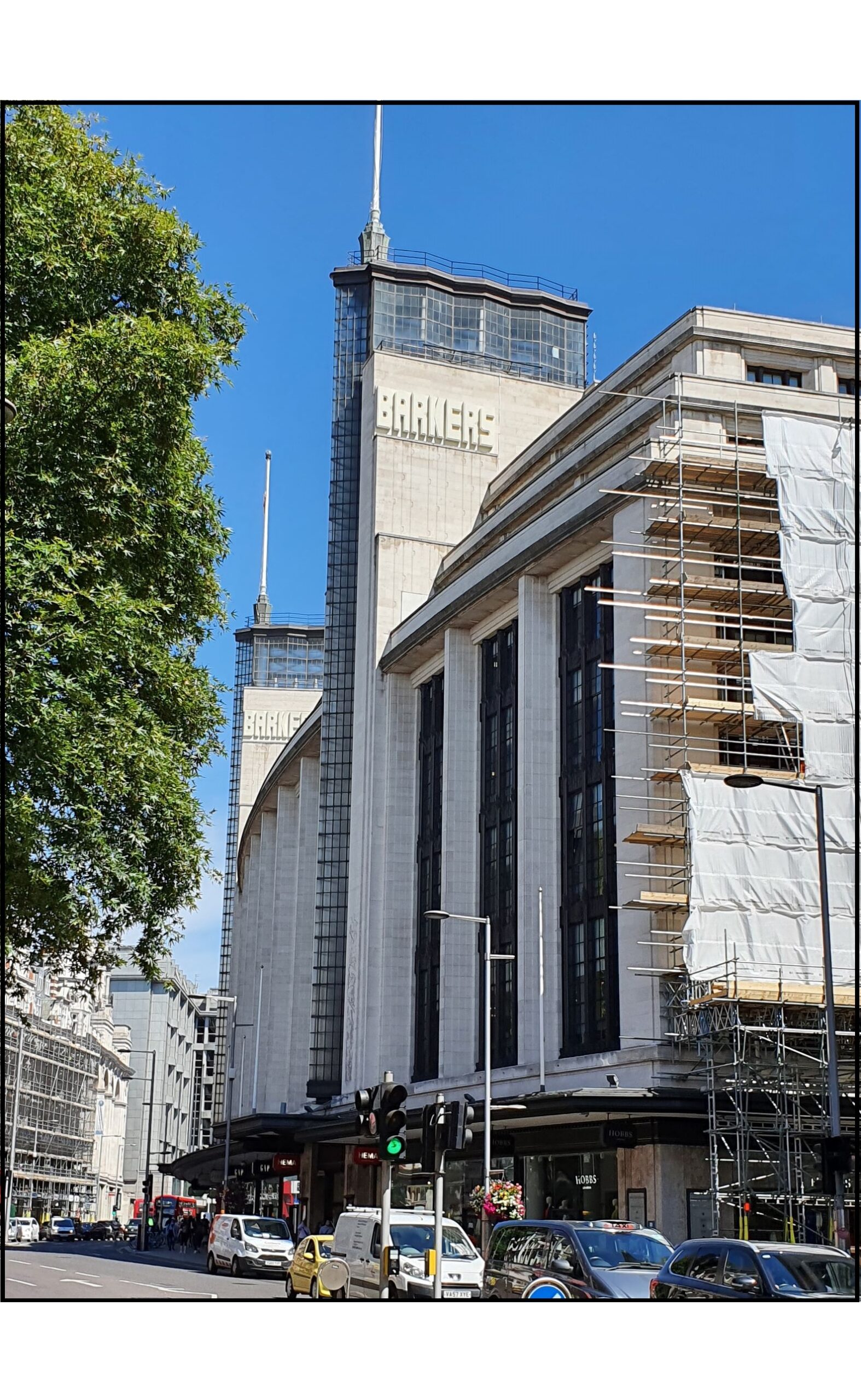
Upmarket Derry & Toms (1853-1973) fell to its neighbour and rival Barkers in 1920, leaving the row of three department stores on Kensington High Street (see also Pontings, below) under a single management. The construction of the magnificent Bernard George-designed 1933 store, with metalwork by Walter Gilbert, shows the confidence Barker’s had in the future of its new subsidiary. The building is famed for being the home of ‘Big Biba’ for a couple of years after Derry & Toms closed on the orders of House of Fraser in 1973
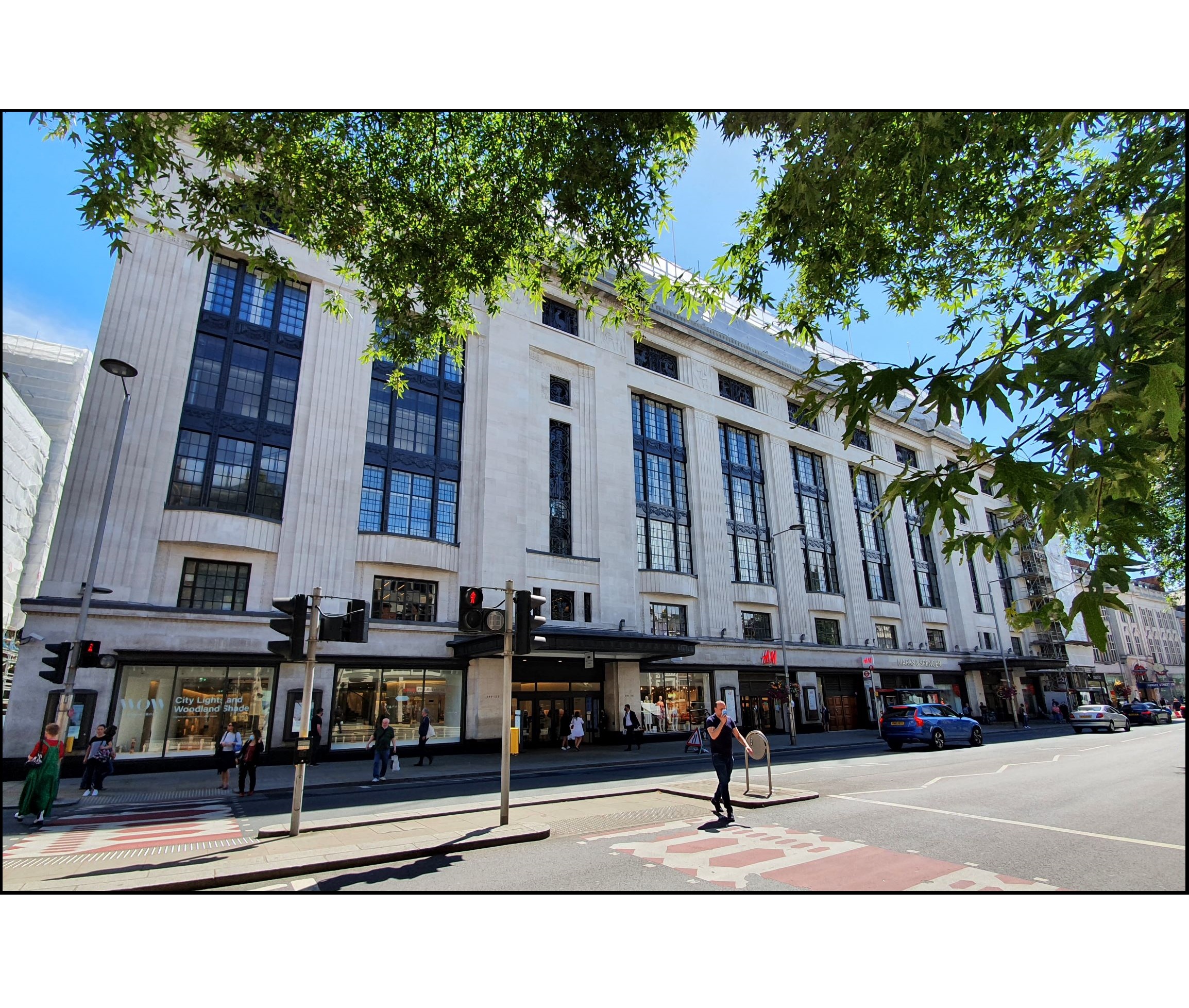
← The attention to detail in the exterior design is astonishing, fully justifying its grade II* listing, but sadly the interior is mainly false ceilings, bland, blank walls and offices. One internal survivor is the Rainbow Room, originally a Derry & Toms restaurant, with oval glazed ceiling dome and columns. It’s now a gym.
The structure far right is all that remains of Pontings.
Another claim to fame is the roof garden, added in 1938. This still exists, although closed to the public since 2018. It remains the largest roof garden in Europe and has separate sections: A Spanish garden with concrete twisted columned pergola, a two storey façade of a Spanish Style house with pantile roof and metal balconies; a Tudor garden with lavender, roses and wisteria, and a woodland garden with an arched stone bridge and a Japanese wooden bridge. The garden is listed grade II* in its own right, and the mature trees have preservation orders on them.
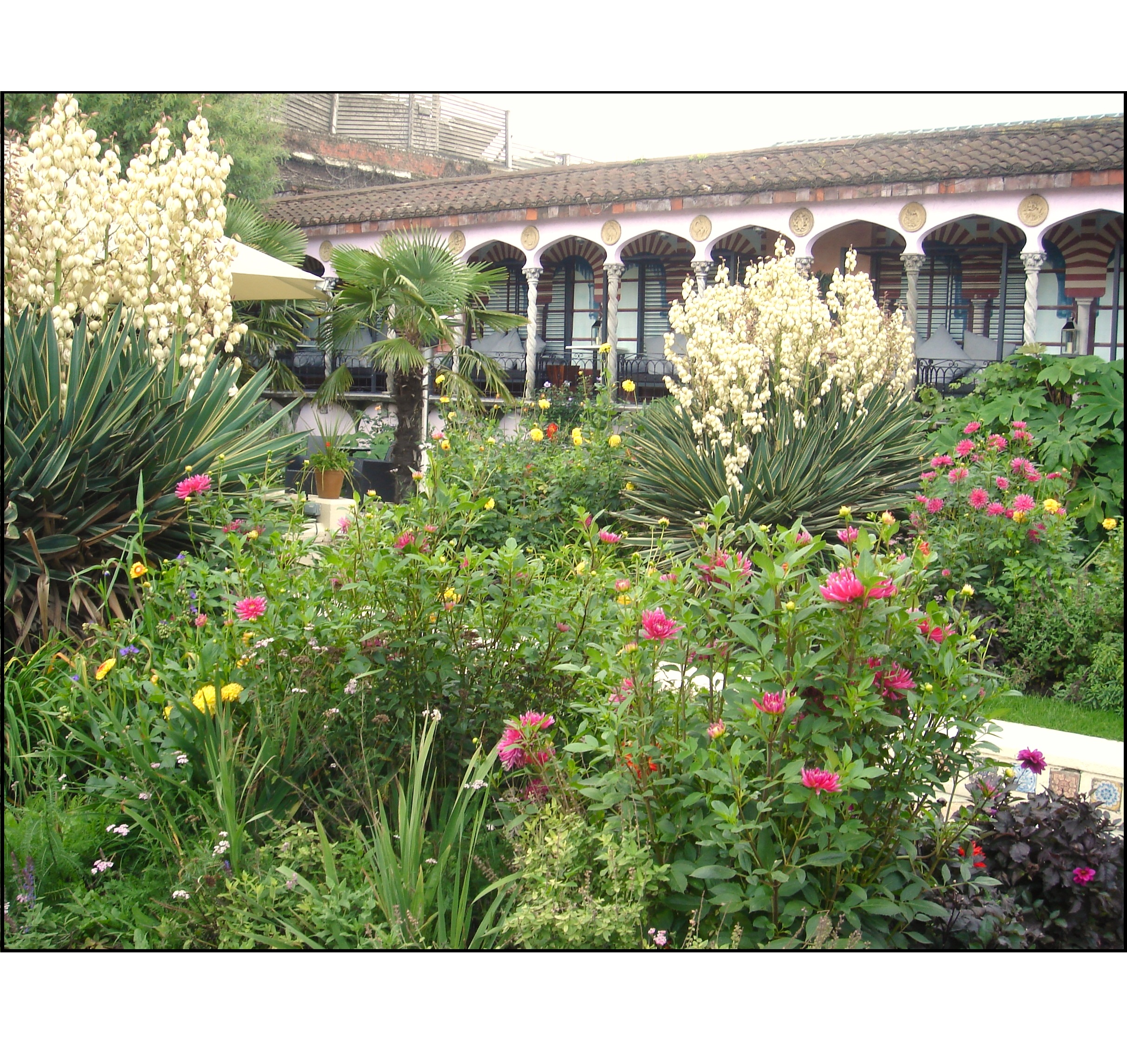
← The Spanish garden, inspired by the Alhambra.
→ The garden’s most famous residents, moved to a sanctuary in 2018.

Ponting’s (1863-1970), by far the most downmarket of the ‘Kensington three’, proved that there was a working class in the vicinity and they did need to buy stuff. It was unique in that it contained an arcaded entrance to Kensington High Street tube station, but ran into financial problems in 1907 and was bought by nearby Barkers. Closed by Frasers – of course – in 1970 as part of a rationalisation plan that later killed off Derry & Toms, its stock was dumped into a ‘bargain basement’ in Barkers. The vast western range of buildings running down Wrights Lane was soon demolished, but I’ve included Ponting’s here as the station arcade survives, embedded in the heavily modernised eastern building. It was the financial strain of constructing this that ended Ponting’s independence more than 100 years ago.
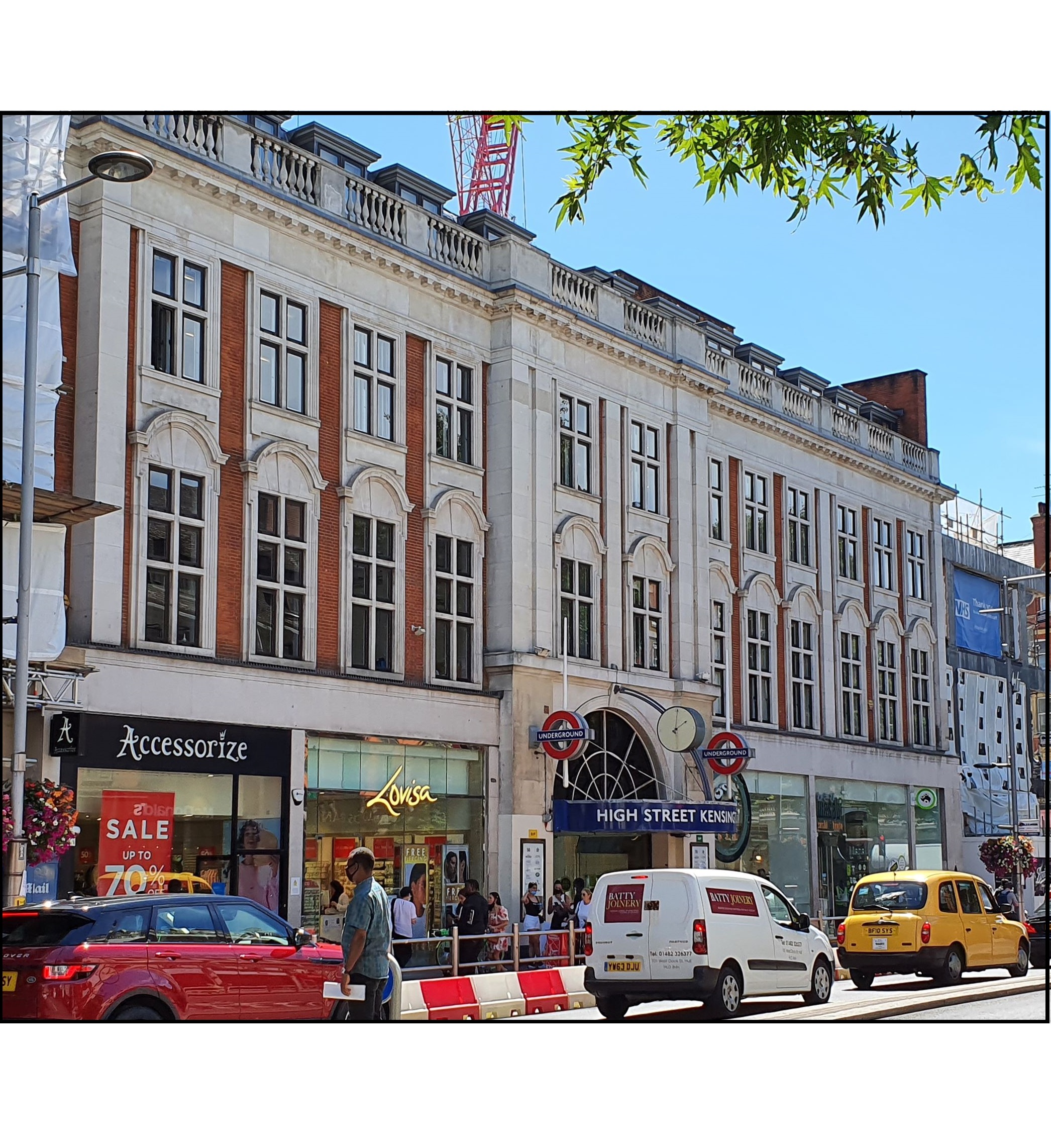
← The surviving eastern building
→ The tube station arcade. One side contained displays by Ponting’s, the other a direct entrance to Derry &Toms.
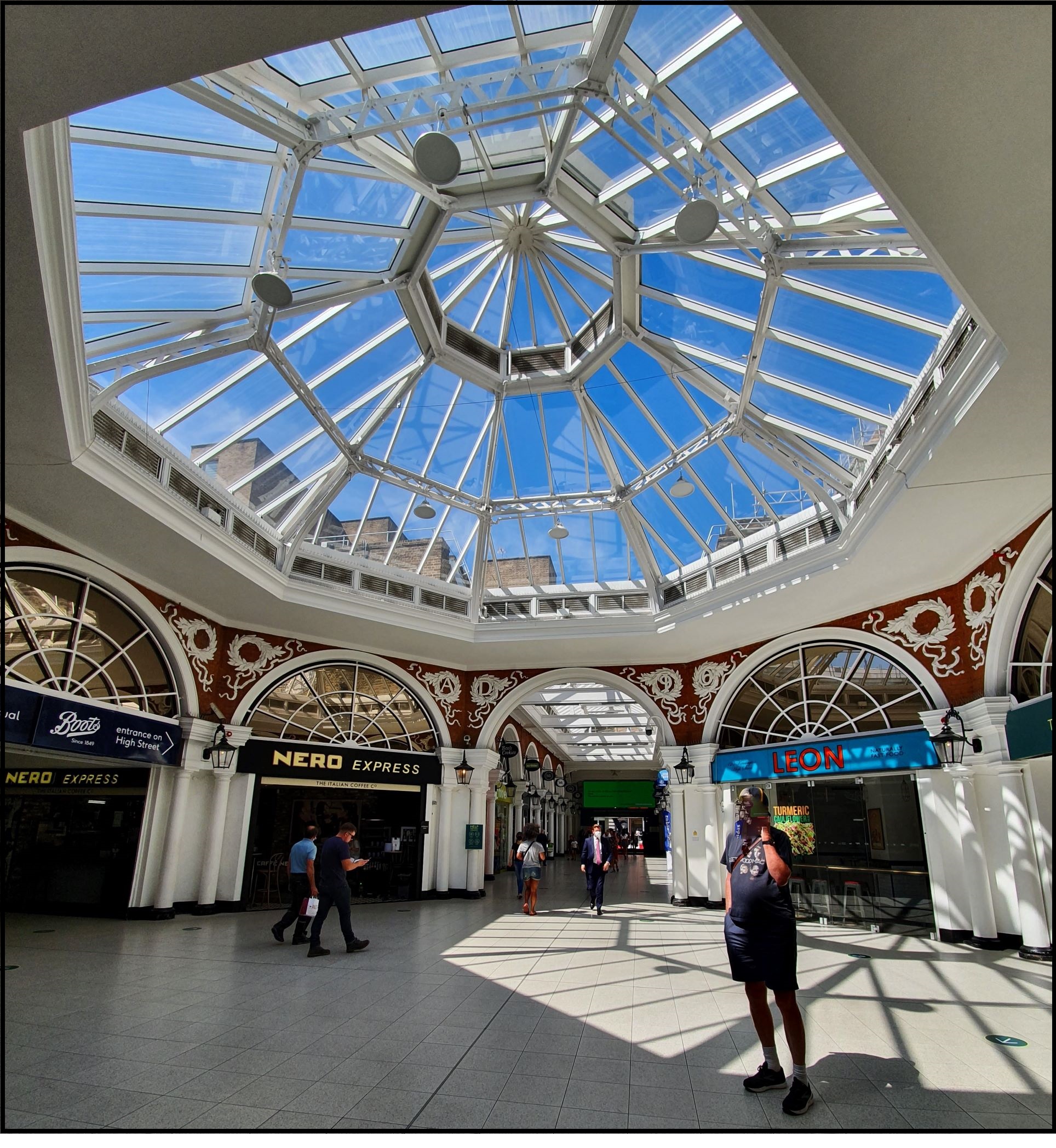
Since the publication of Whiteley’s Folly in 2004, the story of William Whiteley (1831-1907) and his store Whiteley’s of Bayswater (1863-1981) – the ruthlessness, the suspicious fires, Whiteley’s murder, the catastrophic purchase of Whiteley’s by Selfridges – have become well known. Its ultimate failure, however, must be down to its odd location on Queensway, far from any large shopping location, leading to a terminal paucity of customers as department stores became increasingly unfashionable. United Drapery Stores was the owner left holding the keys when the end finally came.
It eventually reopened in 1989 as a shopping centre, when 1980s consumerism appeared to make such an undertaking viable. It turned out that it wasn’t, and the building closed again in 2018.
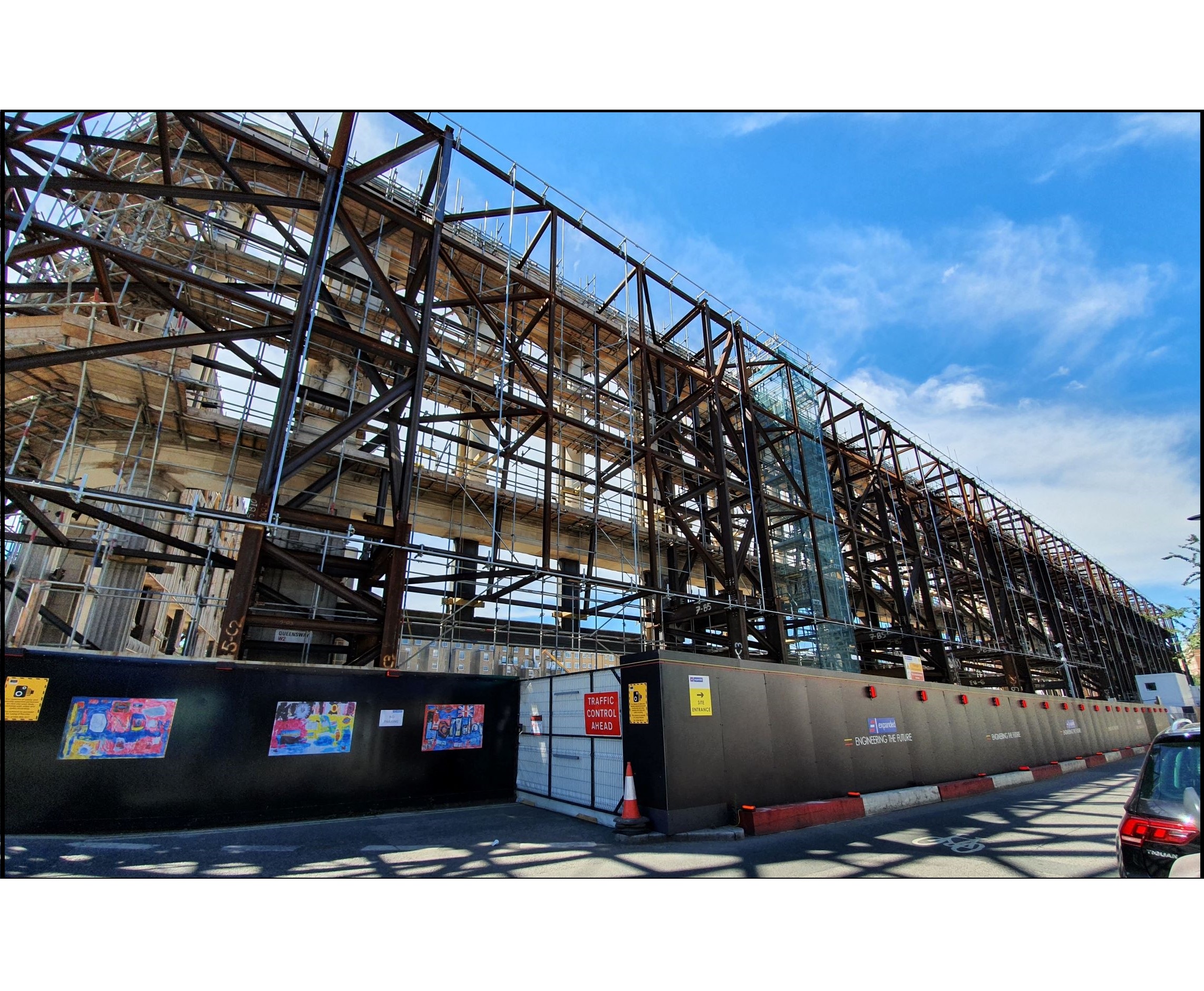
← Sort of still with us – this is the 1925 listed façade in July 2020, robbed of its insides . Its glass dome and corner cupulas – judging by the redevelopment website – will be reinstated. Bayswater can look forward to 139 expensive apartments (just 14 more will be ‘affordable’), an expensive hotel, an expensive spa, a cinema and retail space.
It’s tempting to call this next entry ‘Wickham & Speigalhalter’ rather than Wickhams (c.1880-c.1965). The gap-toothed building left to us owes as much to the stubbornness of the Speigalhalter family as it does to the Wickham family and their huge emporium – the ‘Harrods of the East End’, so-called, and designed to mimic the Selfridges facade.
The story in a nutshell: Having persuaded the Speigalhalter family to relocate their jewelers shop once as the Wickham drapers empire expanded along the Mile End Road near Stepney Green, the Speigalhalters put their collective feet down when asked to do so again in the 1920s. They would not budge, and Wickham’s decided to build its magnificent emporium around the tiny terrace shop.
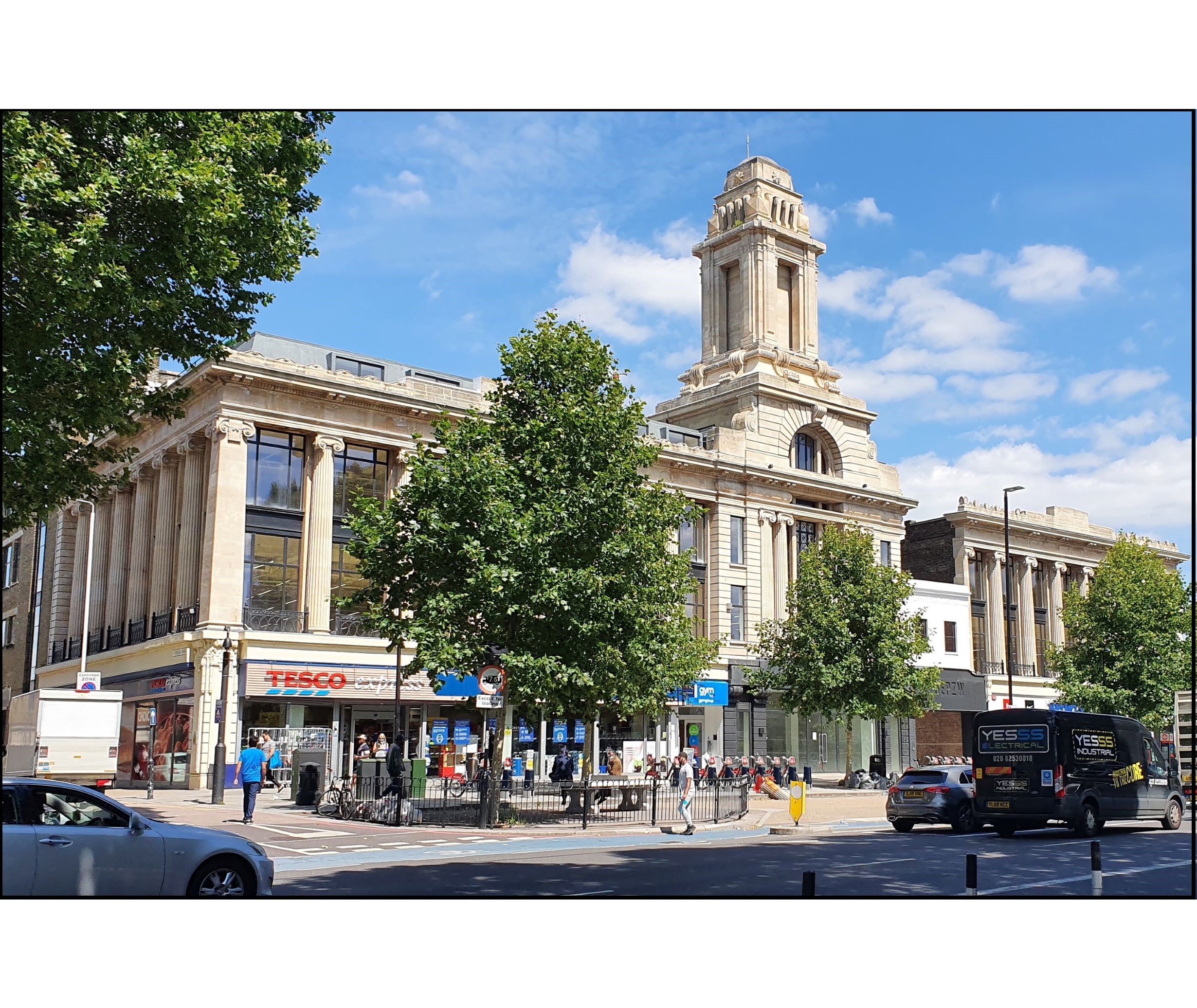
← The eastern wing, separated – at the front only – from the remainder by Speigalhalter’s, is the same length as the western wing. Perhaps the stone had already been ordered.
Wickham’s was an early victim of a swing away from department store shopping. It closed in the 1960s. The Speigalhalter enterprise outlived it, finally closing in the 1980s. The family had changed their name to Salter during the Second World War to avoid anti-German feeling, but the shop remained Speigalhalter to the end.
By 2014 the former jewelers was derelict and roofless, but the site has undergone restoration since, narrowly escaping the total demolition of Speigalhalter and completion of the Wickhams facade in some shape or form. Offices were – inevitably – created behind, and the Speigalhalter shop was left as a restored, symbolic facade – a monument to Wickham hubris. Mind you, at least Wickham’s got its central tower. Selfridges never did.
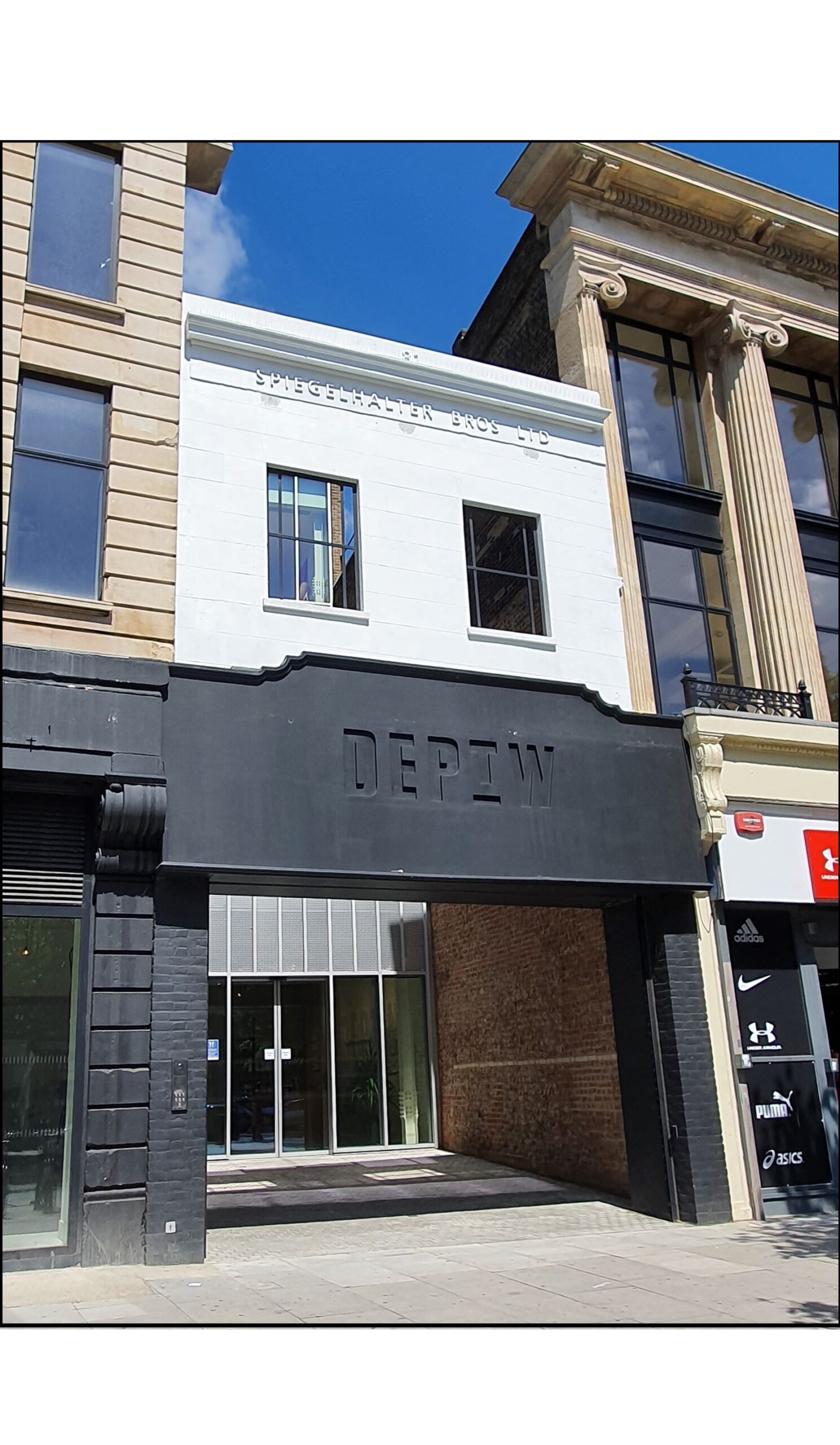
← The view from the front, with the ‘Speigalhalter Bros Ltd’ name still high up on facade, just discernible. None of the site is listed.
→ The surreal view from behind the Speigalhalter facade.
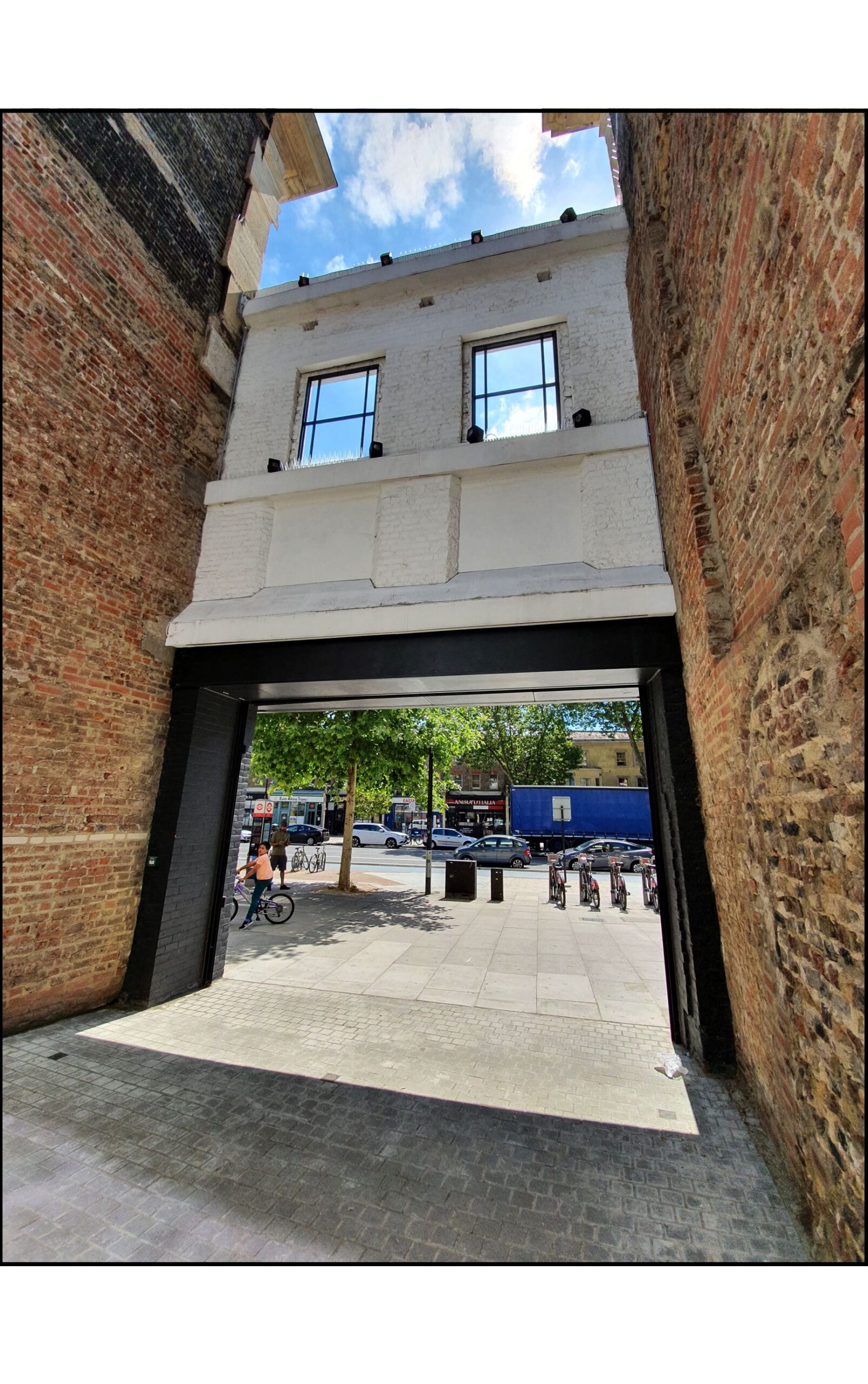
The Civil Service Supply Association (1865-1982) is the most tragic tale here as, having a prime spot between the Strand and Covent Garden, and with no links with House of Fraser or Debenhams, it might still be with us today had most of the building not been consumed by fire in 1982. It never reopened. The red brick and terracotta facade of the gutted 1877 building, and the art deco Strand building both survived, and have been rebuilt as … well, you can guess.
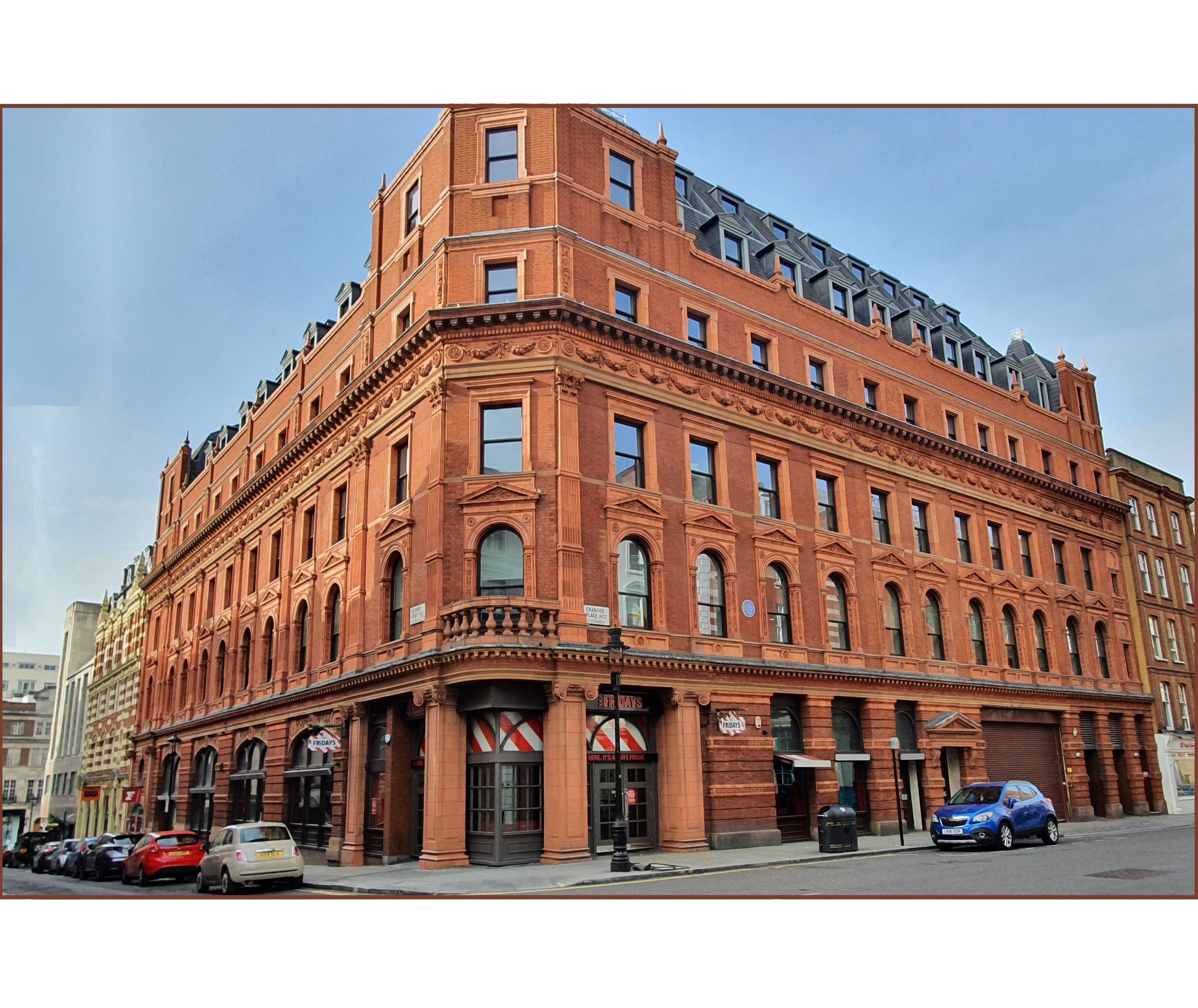
← The rebuilt 1877 Bedford Street/Chandos Place building, with the inevitable new attic floors. Listed grade II. This was originally designed by Lockwood and Mawson, and, according to the Historic England listing, is typical of their Roman Renaissance manner. The Civil Service Stores occupied the entire row of buildings leading down to the Strand on the left.
→ The origin of the store was a cooperative of civil servants working for the GPO, clubbing together to buy tea. Sadly, the landmark blue enamel clock on the Strand frontage is the only clue to a century of history.
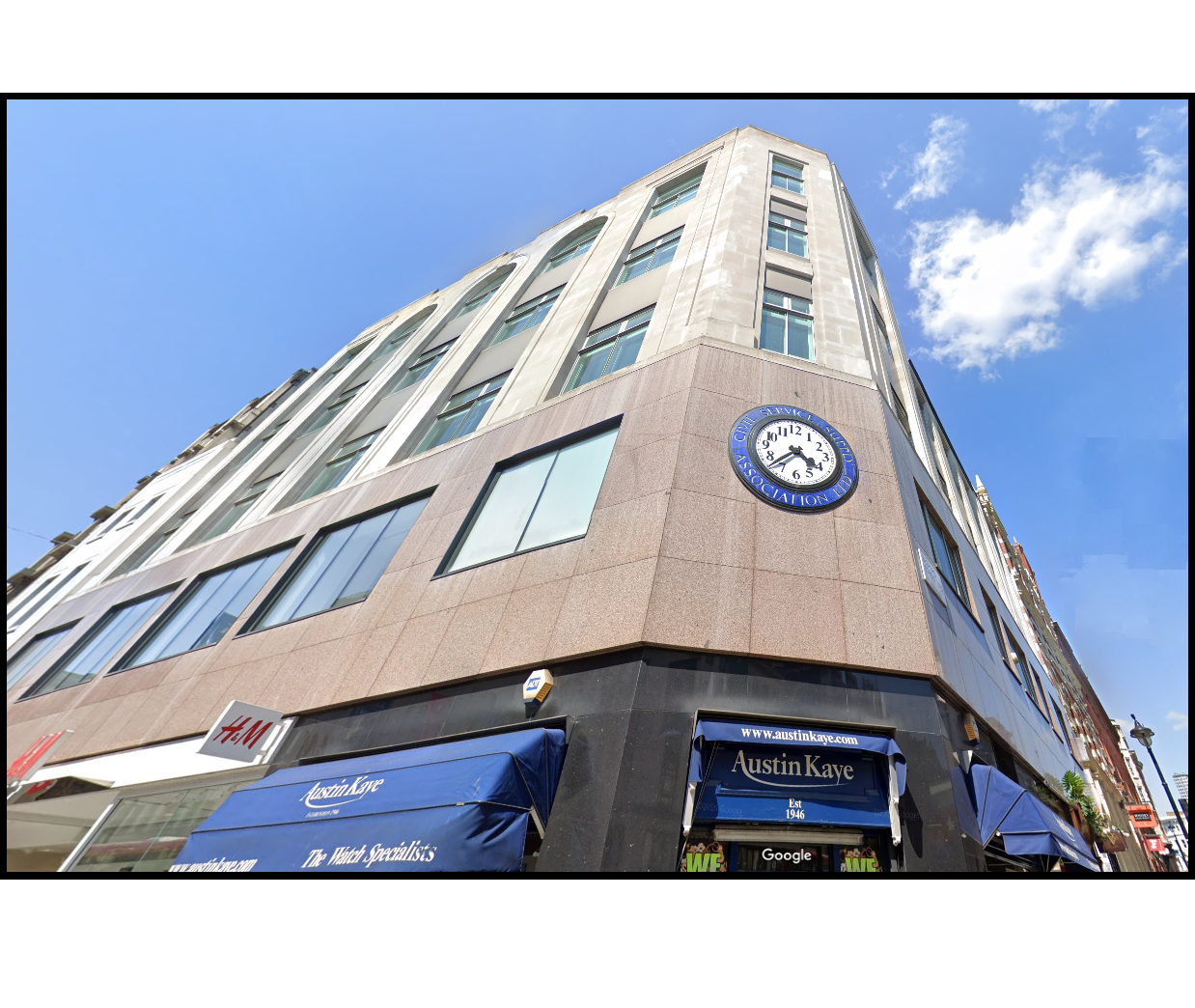
And finally, an overseas curiosity with a London connection – central Buenos Aires is home to a former outpost of ‘informal empire’. We might be used to seeing Harrods emporia at airports and sleek shopping malls where the rich people go, but the company’s first foray abroad was this extraordinary survivor, opened in 1914 and expanded 6 years later with a main frontage on St. Martin. Harrods aimed to exploit the booming British-dominated Argentine economy and the resulting ex-pat community. It was sold in 1922 but the Harrods name remained through successive changes of ownership. A British court case in 1998 ended in victory for the Argentine company over Mohammed Al-Fayed; they retain rights to the name, in Argentina only. The store finally closed later the same year. I had no idea of its existence until, posted to Buenos Aires a decade ago, I walked past the empty building on a day off and was stunned to see the familiar name with an unfamiliar logo.
Despite part of the building being used for arts festivals and permission being granted for full refurbishment, economic crises have prevented any plans from proceeding. However, restoration – to include a department store under Harrods (Argentina) ownership – does finally seem imminent. This is one store that might actually rise from the dead. With apartments and offices above, of course.
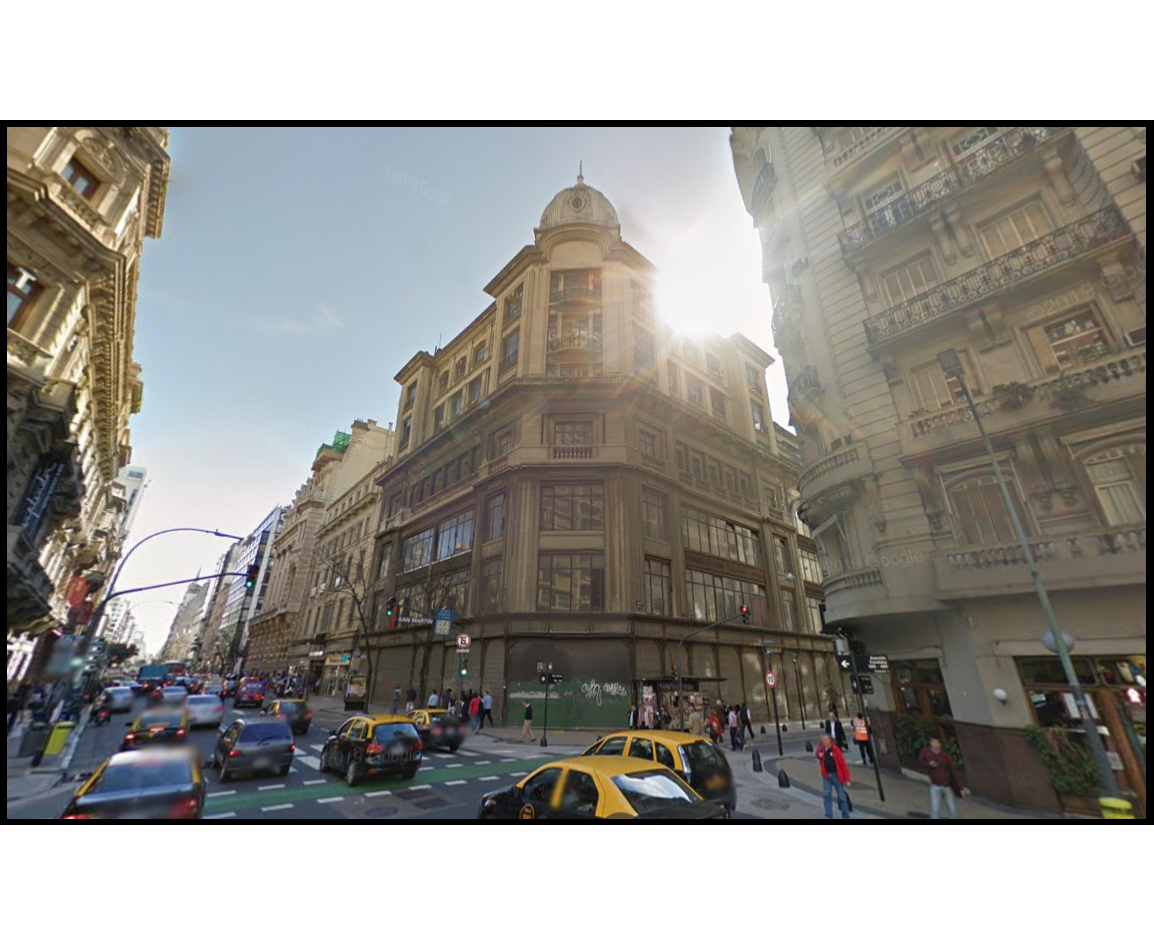
← Harrods’ main street facade, which would bear favourable comparison to most London stores if only you could see it properly, is along the impossibly narrow St. Martin. So here’s the Avenida Córdoba-St Martin corner view. The stunning art nouveau interior is mostly intact, with cedar flooring and wrought iron lifts, and a palatial marble-lined barber shop.
Update January 2023: For those needing a more comprehensive fix of ex-department stores in the capital, including those demolished, Tessa Boase’s excellent and copiously illustrated book “London’s Lost Department Stores” has recently been published. Highly Recommended.
Nearest Stations:
Selected Bibliography:
Credits:
Comments are closed.
I found you on one of my old department store look ups. Your city is full of beautiful of department store buildings.
I have visited London (UK) many times and as old department stores are an interest your city is one of the best at keeping these treasures. Thank you.
Thank you. Sadly, the spate of closures since I wrote that (House of Fraser, Debenhams) has not left such an attractive architectural legacy.